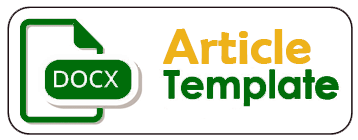RANCANG BANGUN APLIKASI MUSEUM SANGIRAN DENGAN DETEKSI QR CODE BERBASIS ANDROID
DOI:
https://doi.org/10.32497/orbith.v16i2.2095Keywords:
museum Sangiran, QR Code, Android, Eclipse, PhoneGapAbstract
Tujuan dari penelitian ini adalah merancang dan membangun aplikasi Sangiran berteknologi deteksi QR Code pada smartphone android sehingga membantu pengunjung untuk lebih memahami fosil di Museum Sangiran. Aplikasi dibuat menggunakan metodologi waterfall, perangkat lunak Eclipse dan PhoneGap. Dengan aplikasi ini pengunjung dapat melakukan pemindaian QR Code yang terdapat pada fosil dan muncul informasi dalam bentuk suara mengenai sejarah fosil. Aplikasi Sangiran juga memiliki fitur navigasi yang dapat digunakan untuk menunjukkan arah pengguna aplikasi dari tempat pengguna berada menuju Museum Sangiran dan juga menampilkan denah museum beserta lokasi pengguna di area museum. Aplikasi ini telah diuji coba menggunakan metode kuisioner dengan hasil tingkat kepuasan pengguna aplikasi sebesar 85,73% yang berarti pengguna aplikasi merasa puas dengan fungsi dan fitur yang terdapat pada aplikasi.
Kata kunci : museum Sangiran, QR Code, Android, Eclipse, PhoneGap
References
Jawi, I.G.B, Supriyono, H., “Pemindaian QR Code Untuk Aplikasi Penampil Informasi Data Koleksi di Museum Sangiran Sragen Berbasis Android”, 2017, Jurnal Emitor Vol.17 No. 1 Tahun 2017.
Oktrivia, U., “E-Museum: Komodifikasi Informasi Koleksi Museum”, 2014, Jurnal Naditira Widya Vol. 8 No.1 Tahun 2014.
Narayanan, A.S., 2012, “QR Codes and Security Solutions”, International Journal of Computer Science and Telecommunications Volume 3, Issue 7, July 2012.
Jevremovic, V., Petrovski, S., 2012, “Museum ”“ Augmented Reality and QR Codes Enabled Mobile Platform with Digital Library, used to Guerrilla Open the National Museum of Serbia”, 18th International Conference on Virtual Systems and Multimedia.
Downloads
Published
Issue
Section
License
Authors who publish with this journal agree to the following terms:Authors retain copyright and grant the journal right of first publication with the work simultaneously licensed under a Creative Commons Attribution License that allows others to share the work with an acknowledgement of the work's authorship and initial publication in this journal.
Authors are able to enter into separate, additional contractual arrangements for the non-exclusive distribution of the journal's published version of the work (e.g., post it to an institutional repository or publish it in a book), with an acknowledgement of its initial publication in this journal.
Authors are permitted and encouraged to post their work online (e.g., in institutional repositories or on their website) prior to and during the submission process, as it can lead to productive exchanges, as well as earlier and greater citation of published work (See The Effect of Open Access).





